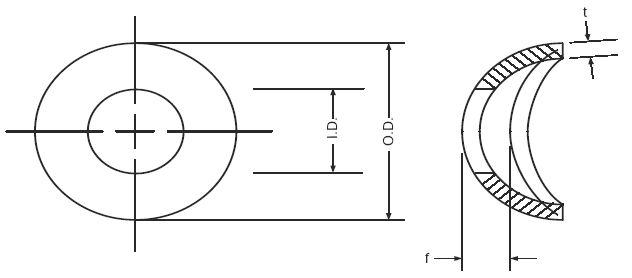Related Resources: calculators
Curved Washer Design Formula and Calculator
Spring Design and Engineering Equations and Calculators
Curved Washer Design Formula and Calculator
Curved washers are used to secure fasteners, distribute loads, absorb vibrations and axial end play, and other similar applications. A typical curved washer is shown in Figure 1. Another special type of curved washer is the Belleville washer. When a load is applied to a curved washer it tends to flatten causing radial and circumferential strains. This elastic deformation constitutes the spring action. Stress is not distributed uniformly in curved washers, the greatest stress occurring at the convex inner edge. Curved washers exert a relatively light thrust load. Bearing surfaces should be hard to prevent washer corners from scoring the shaft.
Figure 1 - Typical Curved Washer

Preview: Curved Washer Design Calculator
The stress on a curved washer is:
Eq. 1
S = ( 6 · EM · f · t ) / (OD)2
Where:
S = Bending stress, lbs/in2, (N.mm2)
EM = Modulus of Elasticity, lbs/in2, (N.mm2)
f = washer deflection, in (mm)
t = washer thickness,
in (mm)
OD = outside diameter, in (mm)
The failure rate of a curved washer is determined using the following equation:
Eq. 2
λSP = λSP,B · ( S / Ts )3 · Ccs · CR · CM
A generalized equation that adjusts the base failure rate of a curved washer considering anticipated operating conditions can be established:
Eq. 3
λSP = λSP,B · CE · Ct · CD · CY · Cf · CCS · CR · CM
where:
λSP = Failure rate of torsion spring, failures/million hours
λSP,B = Base failure rate for torsion spring, 14.3 failures/million hours
CE = Multiplying factor which considers the effect of the material elasticity modulus on the base failure rate
Eq. 4
CE = ( EM / 28.5 x 106 )3
Ct = Multiplying factor which considers the effect of the material
thickness on the base failure rate
Eq. 5
Ct = ( t / 0.025 )3
CD = Multiplying factor which considers the effect of washer diameter
on the base failure rate
Eq. 6
CD = ( 1.20 / OD )6
CY = Multiplying factor which considers the effect of material tensile strength on the base failure rate
Eq. 7
CY = ( 190 x 103 / Ts )3
Ts = Tensile Strength, lbs/in2, (N/mm2)
Cf = Multiplying factor which considers the effect of washer deflection
on the base failure rate
Eq. 8
Cf = ( f / 0.055 )3
CCS = Multiplying factor which considers the effect of a corrosive environment on the base failure rate
Eq. 9a
CCS = 0.100 If CR ≤ cycles/min
Eq. 9b
CCS = CR / 300 ) For 30 cycles/min < CR ≤ 300 cycles min,
Eq. 9c
CCS = ( CR / 300 )3 ForCR > 300 cycles/min,
CR = Multiplying factor which considers the effect of a corrosive environment on the base failure rate
Eq. 10
CR = 1.0 unless or greater than 1.0 with user's experience with the spring and the operating environment.
CM =
Multiplying factor which considers the effect of the
manufacturing process on the base failure rate
Eq. 11
CM = 1.0 a higher value for the multiplying factor is used based on
previous experience with the manufacturer.
Reference:
Handbook of of Reliability Predictions Procedure for Mechanical Equipment
Logistics Technology Support
CARDEROCKDIV, NSWC-11
2011
Related
- Torsion Spring Design Formula and Calculator
- Torsion Spring Arc Length Formula and Calculator
- Torsion Spring Calculator
- Design Equations of Belleville Washer Springs
- Belleville Spring Washer Equation and Calculator
- Torsion Applied Spring Stiffness Constant Equations and Calculator
- Coil-Diameter Tolerances of Torsion Springs Specifications
- Morrison's Spring Tables Design Reference Premium Membership Required to view Document/Book
- Typical Modulus of Elasticity of Spring Materials used in Torsion and Tension
- Mass Spring Simulator and Calculator
- Spring Properties and Material
- Springs Made From Rectangular Section Bar Steel Design and Calculations
- Stresses in Helical Springs Produced by Shocks Formulas and Calculator